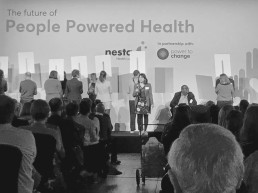The Future of people powered health
Nesta’s six months of planning and development culminated last week into their slick ‘The Future of people powered health’ event, which didn’t disappoint. And it wasn’t just down to the inspirational and thought-provoking speakers, although they left the audience with a lot to think about. The day was enriched by multi-sensory feasts provided by innovators in health, with applications in stroke rehabilitation, custom fitted orthoses, and combating isolation, as well as a hauntingly beautiful orchestral composition by the New Note Orchestra as a form of focused addiction rehabilitation. If that wasn’t enough, it was punctuated by intelligent, passionate delegates with many different but relevant points of view; some of whom we were lucky enough to engage and debate with during the afternoon break-out sessions.
If only a solution to achieving a collaborative and supportive people-powered and data-driven health system, in a time of serious financial pressure, were as seamless and well constructed. Or indeed was decided and implemented by the like-minded experts from this event.
Unfortunately, there seems to be so many hurdles to overcome to achieve even a piece of this ideal, that for an individual it can feel overwhelming and paralysing. As a result, people feel powerless to effect any change at all, so do nothing. Hence nothing changes. Some people in the system even feel threatened by change – worried about it rather than embracing it and pushing the boundaries of possibility to create something new, relevant and stronger.
During the course of the day we heard from people who refused to think like that. People who are thick skinned enough to take the knock backs and get back up again to challenge and fight for what they truly believe in, even when hope has disappeared completely from view.
More than that, these driven and passionate innovators, pioneers if you will, understand their area of expertise through experience and listening from within their local community. Only from this well-informed position can we truly hope to understand a person’s needs rather than making assumptions and dictating solutions. We can then work together to find ways to solve the issues at hand.
They are also confident enough to make themselves vulnerable by not trying to make these changes alone in a silo, but by leaning on experts and experiences around them. Sharing their knowledge and collaborating in order to truly change behaviour and outcomes.
But how can we emulate these pockets of truly life changing projects? Should we even try Maybe a one size fits all approach is antiquated and wasteful in today’s society. Is it about understanding the essence of what these amazing teams are trying to achieve and being flexible and open enough to allow other projects to manifest themselves in different ways that best suit the communities that need them? Can we learn from, support and nurture similar innovations and harness the power of many, and make people feel invested in the future of health?
There are many interesting perspectives and proposals put forward surrounding this subject that we took away from the day, but we’d like to share two with you here. The first directly relates to the title of the event. In order to stop people feeling powerless to change, there needs to be a shift. The more balance of power we can have between people and healthcare professionals, the more invested people will be in their future health. Rather than dictating solutions, if these can be reached on a more equal footing there will be a greater understanding of why, strengthening both adherence of treatment for a diagnosis as well as reaching a diagnosis in the first place.
The second is around social prescribing. This is certainly very pertinent given the recent acquittal of the Belgian doctor who wrote his patient a sick note to get them out of a gym contract they couldn’t afford or use.
The restorative powers of social prescribing on well-being and future health can have exponential gains. Having an understanding of people’s lives and acting accordingly can unlock and rehabilitate in ways that drugs and surgery cannot, having a dual effect of relieving financial burden on our health service and time of HCPs, as well as benefiting the people in need of support and our most vulnerable. We should acknowledge the power social interaction can have on a person. Creating opportunities centred around a task or focus to give people’s lives, in many cases, more meaning and something to talk about. This can be taken a step further, in the right cases, by rehabilitating through the power of helping others to instill a sense of purpose and value.
Although everyone wants to ultimately solve the big problem of ‘people powered health’ and making our future health system workable, everyone can and needs to play their part, however small. The more people having meaningful conversations, listening, collaborating and challenging, the better. It’s amazing the ripple effect all this activity can have.
#peoplepoweredhealth #iseeu
Being social
Being social used to mean being just that. Now it means almost the opposite – being glued to a device and barely making meaningful contact with other human beings in the real world.
Now, I’m not in any way against social media (that would be ironic for a post shared through social channels), but has our obsession been at the expense of real-life interaction, instead of in addition to it? Research has shown that virtual interactions don’t produce the same responses in the brain as interactions face-to-face. Even simple things like making eye contact with someone can increase dopamine and oxytocin, and decrease cortisol, reducing stress, increasing trust and improving mood.
And it’s much more powerful than that – Professor Julianne Holt-Lunstad studied the impact of different lifestyle factors on how long we will live. She discovered that some of the physical factors we focus so much on, like being overweight or exercising regularly, only had a moderate impact on life expectancy, and the biggest predictors by far were whether or not people have close relationships and regular social interaction. Research by Prof Clive Ballard also showed that dementia patients spending just 10 minutes a day having a one-on-one social interaction can improve their quality of life, agitation levels and neuropsychiatric complications. That’s the kind of response we might only expect to achieve with hard drugs, not a simple chat.
Physical factors are obviously important, but the focus on physical vs psychological factors is clearly out of kilter. We could all improve our health and wellbeing, and expect to live longer as a result, if we preserve time in our busy lives for talking to people. For most of us that’s pretty easy, but not for everyone. In her recent TED talk, psychologist Susan Pinker stated that “social isolation is the public health risk of our time”.
Channel 4’s Old People’s Home for 4 Year Oldsrecently highlighted a beautiful example of how human interaction can improve our wellbeing. A group of 4-year-olds spent six weeks at an old people’s home, and in that time the senior volunteers showed dramatic improvements in their mental and physical health scores. People who felt they could only walk with a zimmer frame were seen chasing the little nippers around playfully, totally forgetting their physical inabilities. More anecdotally, the older participants said they felt more alive and that being with the children had been like having a shot of adrenalin. There it is again – human interaction having the impact we might only expect from a drug.
So, shouldn’t we be doing much more to recognise the power of human interaction in improving our mental and physical health? In the communications industry, everything we do is about having conversations with people, but it feels like we’re often so focused on how to talk to people, that we forget the importance of actually talking to people.
We need to make it happen. So go and find someone to have a chat with, and maybe you’ll both feel better for it.

